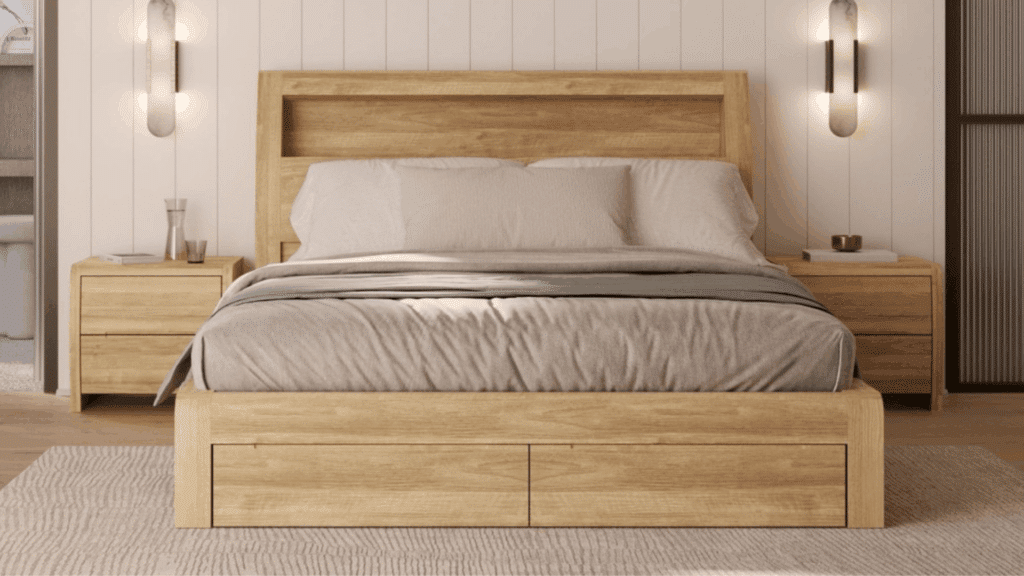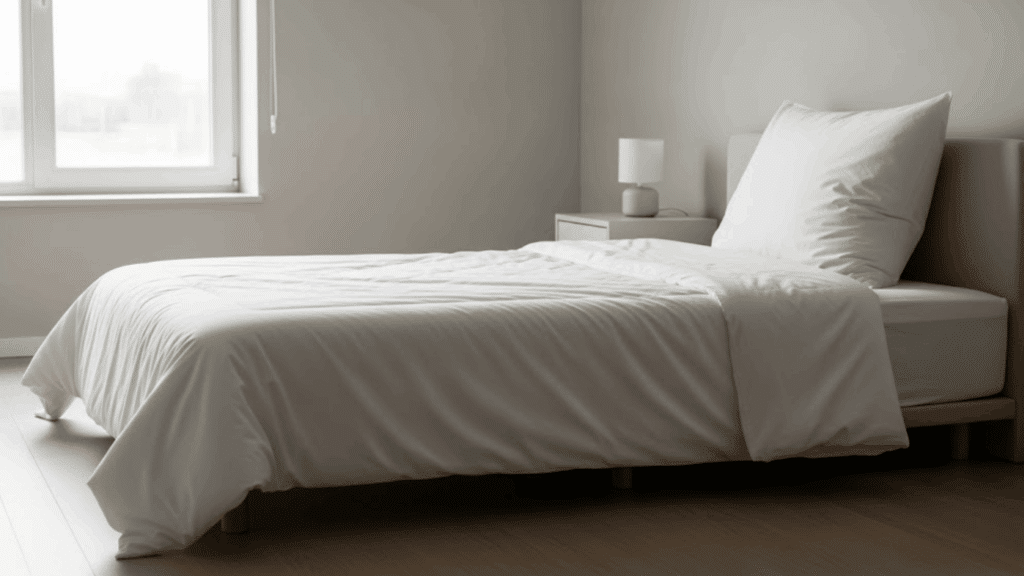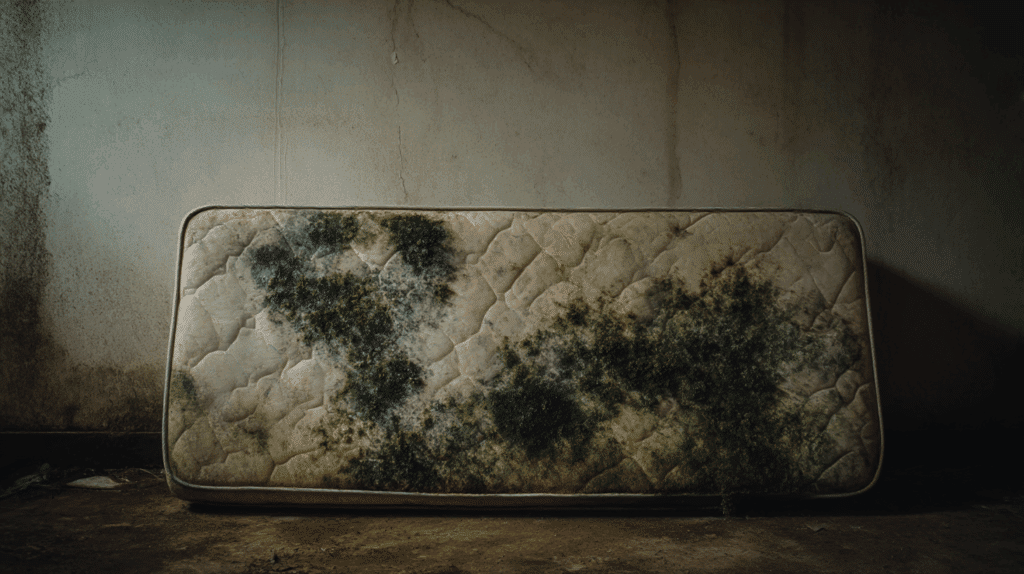Understanding your bed’s parts may not sound exciting, but it makes a big difference.
If you’re shopping for a new setup, troubleshooting squeaks, or assembling one from a box, knowing what each part does saves you time, money, and headaches.
You’ll be able to spot problems early, ask smarter questions in the store, and make better long-term choices for comfort and durability.
Plus, if you’re into DIY upgrades or room makeovers, knowing your bed’s bones gives you total control over its look and function.
From frames and slats to adjustable bases and clever storage, every part plays a role in how well you sleep.
So let’s break down the structure, support, and secret features behind the thing you spend a third of your life on your bed.
Why Learning the Parts of a Bed Matters?
Understanding bed parts gives you real advantages when making sleep-related decisions.
First, you’ll make smarter purchasing choices by knowing exactly what features matter most for your comfort and budget. When problems arise, you can identify issues quickly and find the right solutions or replacement parts.
During assembly, you’ll follow instructions better and avoid common mistakes that could damage your bed or affect its stability.
When talking to salespeople, you can ask specific questions and avoid being oversold on unnecessary features.
Finally, proper knowledge helps you maintain each component correctly, extending your bed’s lifespan and ensuring years of comfortable sleep.
This understanding ultimately saves you money and improves your sleep quality.
Bed Frame Parts Explained: From Headboard to Feet

The bed frame holds everything together. It’s like the bones of your bed. Without a strong frame, your mattress won’t last long.
1. Headboard
The headboard sits at the top of your bed where your head rests. It keeps pillows from falling off, protects walls from getting dirty, and provides comfortable back support when reading or watching TV.
Available in wood, metal, or fabric materials, headboards also make bedrooms look complete and finished while serving as the room’s focal point.
2. Footboard
The footboard sits at the bottom of your bed, opposite the headboard. While not all beds include one, footboards prevent sheets and blankets from sliding off during sleep.
They create visual balance with the headboard, stop mattresses from shifting, and add style to your bedroom’s overall appearance and design.
3. Side Rails
Side rails connect the headboard and footboard, running along both sides of your bed. These essential components hold your mattress securely in place and prevent you from rolling out during sleep.
Made from wood or metal, side rails support significant weight and connect all frame parts together for structural stability.
4. Center Support Beam
Large beds, such as queen and king sizes, require extra middle support to prevent sagging. The center support beam runs across the bed’s width, distributing weight evenly across the entire mattress surface.
This crucial component strengthens the frame, prevents mattress damage, and helps your sleep surface last significantly longer while maintaining proper support.
5. Legs and Feet
Bed legs lift your entire bed frame off the floor, creating important benefits. They allow air circulation underneath, preventing moisture buildup and mold growth.
Mattress Support Systems

This space also enables easy cleaning and provides a valuable storage area. Some beds feature wheels on legs for easy movement, while others offer adjustable heights for different preferences.
A mattress needs solid support to stay comfortable and last longer. The most common support options are slats, cleats, and box springs.
Slats are narrow wooden or metal strips that run across the bed frame. They hold the mattress, allow airflow, reduce sagging, and distribute weight.
Solid slats are flat and firm, while curved slats bend slightly for added flexibility. Slats should be no more than 3 inches apart; wider gaps can cause the mattress to sag.
Cleats are small wooden or metal strips attached to the side rails. They keep slats in place, ensure they stay level, and add extra strength to the bed frame.
Box springs are fabric-covered frames with springs inside. They sit below the mattress to raise bed height, absorb shock, and improve comfort.
However, platform beds don’t need a box spring because they already have a supportive surface built in.
Inside the Mattress: Layers and Materials That Impact Comfort
The mattress is where you actually sleep. Modern mattresses have many layers that work together.
Mattress Materials
Each type of mattress feels different:
- Memory Foam – Shapes to your body and reduces pressure
- Innerspring – Uses coils for bounce and firm support
- Latex – Natural, firm, and breathable
- Hybrid – Combines foam, springs, or latex for balanced comfort
Mattress Layers
Most mattresses include these layers:
- Cover – Protects the inside materials
- Comfort Layer – The soft, top layer you lie on
- Support Core – The strong middle layer that holds your weight
- Base Layer – The bottom layer that adds structure and durability
Different Bed Types and Their Key Components
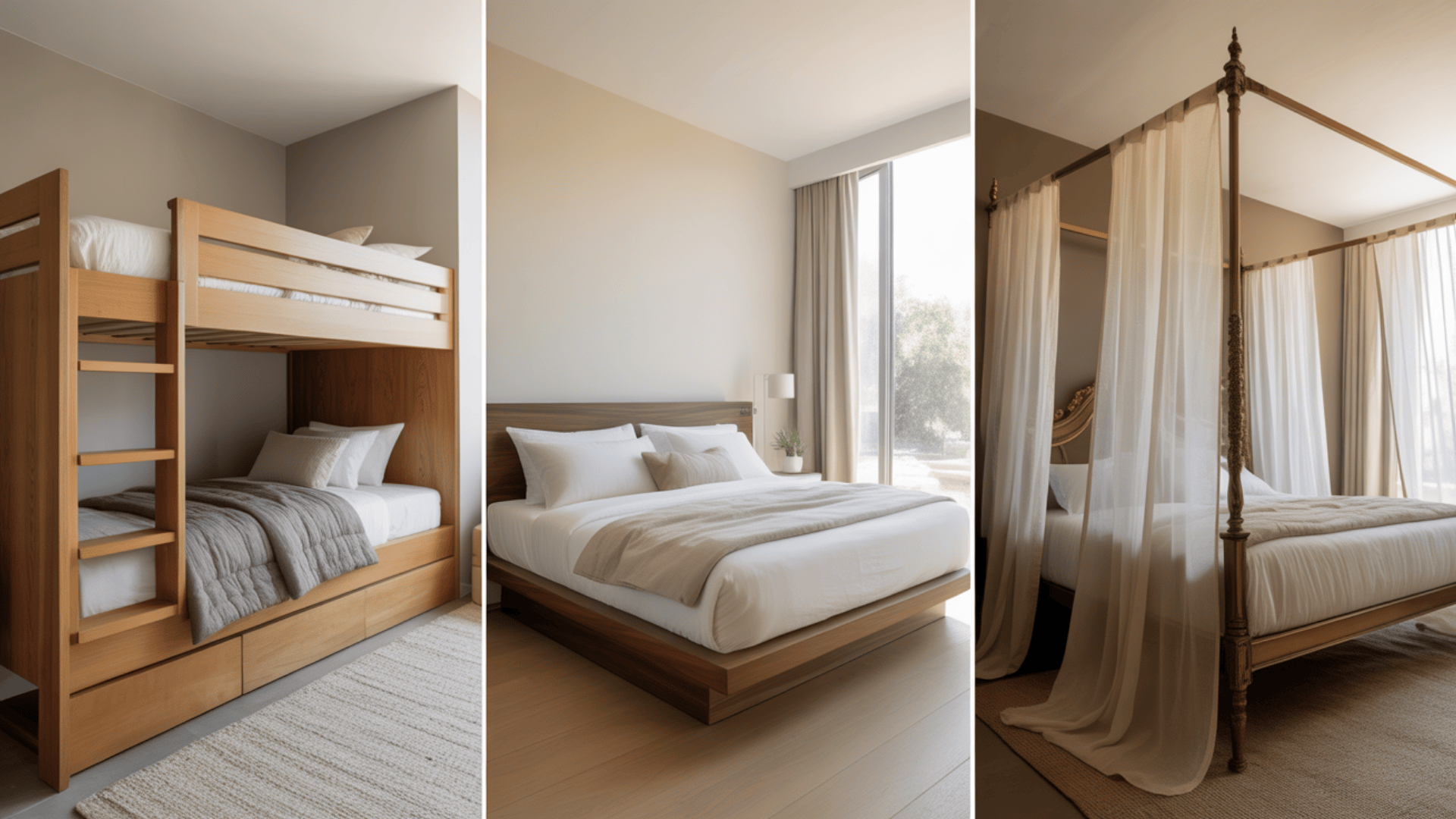
Beds come in many designs, each with unique features that suit different needs, styles, and spaces.
Below are some of the most common bed types and the key components that make them functional and stylish.
1. Bunk Beds
Bunk beds are stacked one on top of the other. They save space and are popular for kids and shared rooms.
| FEATURE | DESCRIPTION |
|---|---|
| Ladder | Allows safe and easy access to the top bunk |
| Guard Rails | Protect sleepers on the upper bed from falling off |
| Strong Frame | Built to support the combined weight of two mattresses and sleepers |
| Special Mattresses | Typically thinner than standard to ensure safety and proper fit on each level |
2. Platform Beds
Platform beds are simple and don’t need a box spring. They sit lower and offer a modern look.
| FEATURE | DESCRIPTION |
|---|---|
| Solid Platform | A flat, sturdy surface that directly supports the mattress |
| Low Profile | Sits closer to the floor, offering a sleek and compact appearance |
| Modern Look | Features a clean, simple design that fits well with contemporary decor |
| Built-In Storage | Often includes drawers or shelves underneath for extra storage space |
3. Canopy Beds
Canopy beds have tall posts and a frame above. They’re often used for style or added privacy.
| FEATURE | DESCRIPTION |
|---|---|
| Four Posts | One tall post at each corner of the bed frame |
| Top Frame | A horizontal structure that connects the four posts at the top |
| Curtains | Optional fabric panels that hang from the top frame for privacy or decoration |
| Classic Style | Offers a traditional look that adds to the bedroom style |
Storage and Extra Features
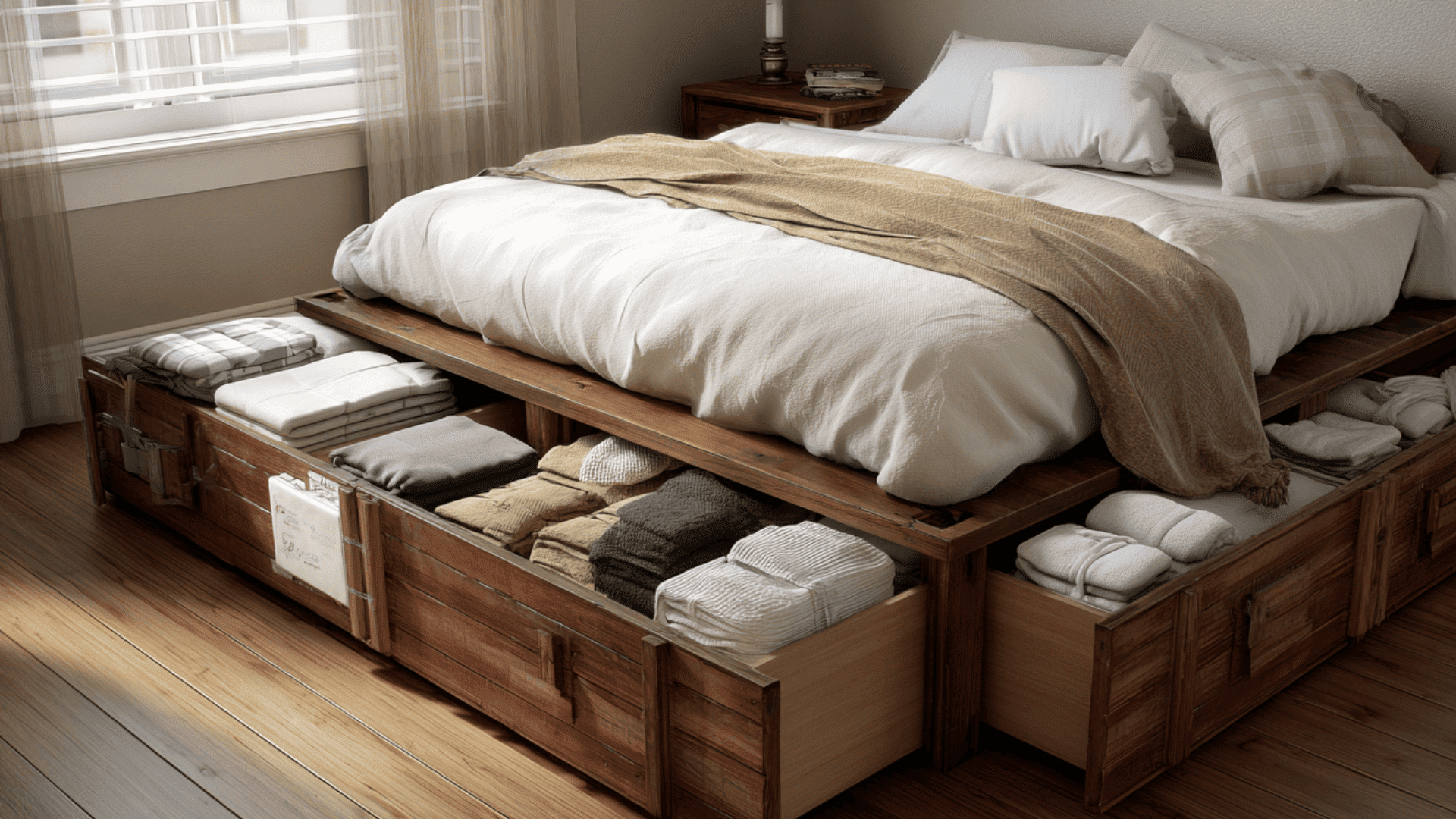
Many beds come with helpful extras. Some are mentioned below.
Under-Bed Storage
The space beneath your bed can be a great spot for extra storage. Many beds come with built-in drawers that slide out from the frame, making it easy to store clothes, toys, or bedding.
If your bed doesn’t have drawers, you can use rolling boxes that slide in and out with little effort. Vacuum storage bags are also helpful for packing away blankets or seasonal clothes, as they save space and keep items clean.
Clear plastic bins are another good option; they’re easy to stack and let you see what’s inside without opening them.
Adjustable Features
Some beds are designed to change shape to improve comfort and support. An adjustable base lets you raise or lower your head and feet, which can help with reading, relaxing, or sleeping better.
Many models come with split systems, so each side of the bed can move independently; great for couples with different sleep needs.
Most adjustable beds include a remote control, making it easy to find the perfect position with the push of a button.
These beds may also offer health benefits, such as better breathing, reduced snoring, and improved circulation.
How to Care for All Parts of Your Bed for Long-Term Use
Taking care of your bed properly extends its life and keeps it comfortable. Regular maintenance prevents problems before they start and saves money on replacements.
- Clean regularly: Vacuum your mattress monthly and wash all bedding weekly in hot water to remove dust, allergens, and bacteria
- Rotate your mattress: Turn it every 3-4 months to prevent uneven wear and maintain proper support across the entire surface
- Tighten hardware: Check and tighten all screws, bolts, and connections twice yearly to prevent wobbling and structural damage
- Inspect for wear: Look for signs of damage like broken slats, worn fabric, or bent metal parts that need immediate replacement
- Maintain proper support: Ensure slats are properly spaced and center beams remain stable to prevent mattress sagging
- Control moisture: Keep your bedroom well-ventilated and use mattress protectors to prevent mold, mildew, and odor buildup
Simple maintenance habits keep your bed working well for years. A little effort now prevents bigger problems and expensive replacements later.
Conclusion: Why Knowing Bed Parts Helps You Sleep Better
Knowing the parts of a bed helps you choose better, fix issues faster, and sleep more comfortably for years to come.
From the frame and slats to storage drawers and adjustable bases, every part plays a key role in support, stability, and style.
When you understand how each component works, you’ll avoid common mistakes and get the most value from your purchase.
Plus, regular care becomes easier when you know what to check and maintain. If you’re upgrading your setup or just curious, this knowledge puts you in control of your comfort.
Have questions about your current bed or shopping for a new one? Drop a comment below; we’d love to hear from you!

